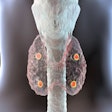
Shear-wave ultrasound elastography (SWE) can reliably predict thyroid cancer and serve as a useful adjunctive tool to grayscale ultrasound, according to a report published online by the European Journal of Radiology.
In a retrospective study of 453 patients, a team led by Dr. Ah Young Park of Yonsei University College of Medicine in Seoul, South Korea, found that high SWE elasticity indices (EI) were independent predictors of thyroid malignancy.
"Quantitative parameters of SWE were predictive factors of thyroid malignancy and SWE EI combined with grayscale US [ultrasound] was adjunctive to the diagnostic performance of grayscale US for predicting thyroid malignancy," the authors wrote in their article, which was posted online on 26 November.
 High SWE EI are independent predictors of thyroid malignancy.
High SWE EI are independent predictors of thyroid malignancy.While grayscale ultrasound plays an important role in assessing thyroid nodules, each of the sonographic characteristics that suggest malignancy has relatively low sensitivity. Furthermore, prior studies have found "considerable overlap" of ultrasound findings in benign and malignant nodules, according to the researchers.
Other studies in the literature have explored the use of ultrasound elastography, but its use in the thyroid has been controversial. Static compression elastography also has limitations, including a lack of quantitative assessment as well as low reproducibility, they stated.
Shear-wave elastography has recently emerged as a reproducible and quantitative technique, but a reference standard for optimal EI cutoff values for predicting malignancy hasn't yet been established. As a result, the Korean researchers sought to make use of large-scale quantitative SWE data to validate the usefulness of SWE and to establish an EI reference value for predicting thyroid cancer.
The team retrospectively analyzed 476 thyroid nodules from 453 patients who had received grayscale ultrasound and SWE prior to undergoing ultrasound-guided fine-needle aspiration (FNA) or surgical excision between March 2012 and December 2012. Of the 476 nodules, 97 were malignant and 379 were benign.
All thyroid ultrasound studies had been performed using an Aixplorer scanner (SuperSonic Imagine) with a 15-4 MHz linear-array probe by two radiologists with 10 years to 15 years of thyroid ultrasound experience. After reviewing grayscale ultrasound findings and SWE EIs and comparing them with benign and malignant nodules, the researchers then calculated optimal cutoff values for predicting thyroid nodule malignancy.
The group found that malignant thyroid nodules had significantly higher EIs compared with benign nodules (p ≤ 0.001).
Optimal EI cutoff values for predicting thyroid malignancy were listed as follows:
- Emean (the mean value for a 2-mm diameter ROI placed in the stiffest region): 85.2 kPa
- Emax (maximum pixel value for a region-of-interest): 94.0 kPa
- Emin (minimum pixel value for a region-of-interest): 54.0 kPa
Both Emean (odds ratio: 3.071, p = 0.005) and Emax (odds ratio: 3.015, p = 0.003) offered independent predictors of thyroid cancer, noted the researchers. They also yielded higher sensitivity when the results were in combination with grayscale ultrasound.
| Diagnostic performance | ||
| Sensitivity | Area under the curve (AUC) | |
| Grayscale ultrasound | 92.9% | 0.769 |
| Combination of Emean with grayscale ultrasound | 95% | 0.820 |
| Combination of Emax with grayscale ultrasound | 95.5% | 0.834 |
The sensitivity and area under the curve improvements were both statistically significant (p ≤ 0.005).
"We observed that combining grayscale US findings and each EI showed elevated sensitivity and elevated AUC for predicting malignancy, compared with the use of grayscale US findings only," they wrote. "Therefore, we suggest that quantitative SWE finding of Emean ≥ 85 kPa or Emax ≥ 94 kPa could improve the prediction of malignancy for thyroid nodules with grayscale US findings and SWE could be used as useful adjunctive tool for diagnosis of malignancy in addition to conventional grayscale US in routine clinical situation."
The authors also recommended that their results be validated in a prospective randomized study.



















